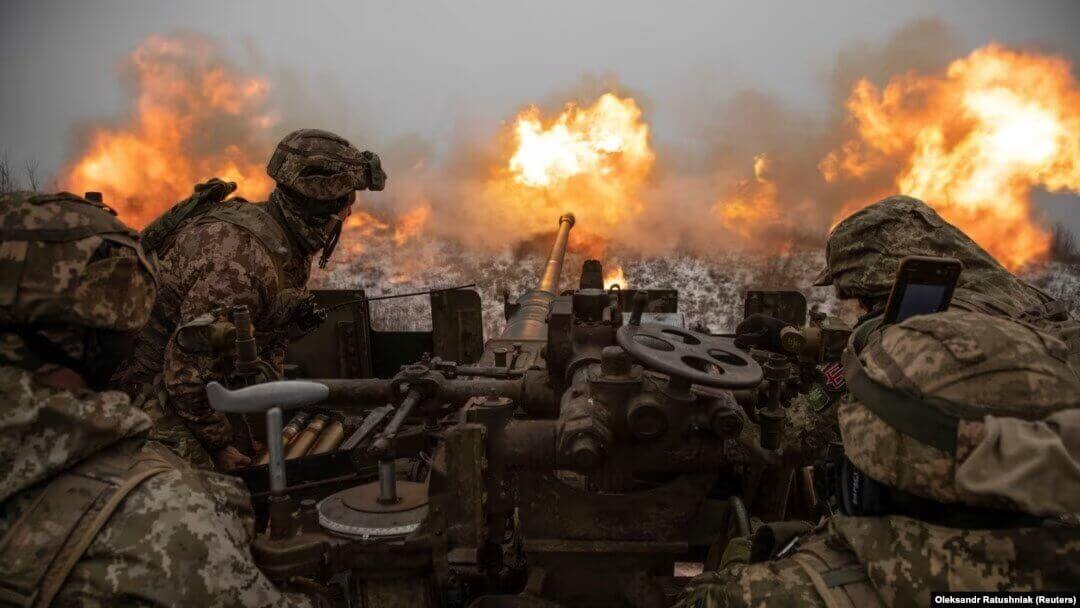According to sources in Kyiv, Russian forces are intensifying the use of heavy artillery and airstrikes in the Donetsk region’s city of Bakhmut, a hot spot in Russia’s war with Ukraine.
Ukrainian Deputy Defence Minister Hanna Maliar stated late Monday on Telegram that Russian offensive in Ukraine’s east is ongoing, emphasising that Bakhmut and the town of Marinka remain “at the epicentre of hostilities.”
Maliar reported that Russian attacks on the towns of Lyman, Avdiivka, and Marinka were unsuccessful, and assaults on Kupyansk, as reported by the Ukrainian General Staff, were also repelled.
Russia’s Defensive in Ukraine
Brady Africk, an analyst at the American Enterprise Institute and researcher in open-source intelligence, stated that new trenches, anti-vehicle barriers, and revetments for equipment and materials have emerged from the Russian city of Voronok down through eastern Ukraine and southwest to the Crimean Peninsula.
Satellite visuals of hundreds of additional defensive positions examined by Reuters suggest Russia has been digging in at critical strategic areas in preparation for an offensive by the Ukrainian military. Visuals also indicate that Russia is heavily defending the southern Zaporizhzhia area, which acts as a gateway to the Crimean Peninsula, and along the Ukrainian front lines.
Africk claimed that his research demonstrated the prevalence of Russian anti-vehicle ditches and barriers across Ukraine, including “dragon’s teeth” — concrete pyramid blocks placed in staggered rows to impede tanks.
The anti-tank trenches are deep and wide enough to hinder approaching tanks and armoured vehicles. The manned trenches are located around a kilometre behind the ditches. Russia’s defensive lines contain minefields, razor wire, camouflaged weapons positions, ditches, barricades, and zig-zag trenches.
John Ford, a research associate at the Middlebury Institute of International Studies at Monterey, said he “traced ditches and trenches running from the eastern bank of the Dnipro, south of Vasylivka, all the way to Fedorivka, which is to say they run across Zaporizhzhia (Region).”
A counteroffensive by Ukraine might alter the trajectory of a war that has stalled and devolved into a brutal battle of attrition. Military analysts say that the length of the front could strain Russia’s defences.
⚡️2 killed, 16 injured as Russia attacks 8 Ukrainian regions over past day.
— The Kyiv Independent (@KyivIndependent) April 26, 2023
Russia struck a total of 122 settlements using various types of weapons, Ukraine's Defense Ministry media center said on April 26.
Photos from Donetsk Oblast: Governor Pavlo Kyrylenko/Telegram pic.twitter.com/nOIawUcM17
Ukraine’s South a Strategic Standpoint
According to the images examined by Reuters, most of the Russian troops’ construction took place after November, when its soldiers withdrew from Kherson city in the south, and both sides sought to fortify positions through the winter months. Military analysts believe the defences stretching hundreds of miles represent locations where Russia expects to be attacked or sees strategic value in retaining land.
Military analysts predicted that the primary move of a counteroffensive would be in the south, even though the toughest combat in recent months has been centred in the east, particularly around the city of Bakhmut. Oleksandr Musiyenko, a military analyst in Kyiv, claimed that Ukraine’s south was crucial from a strategic standpoint.
Analysts at the U.S.-based Institute for the Study of War said in their latest assessment that #Russian forces continue to mount ground attacks in and around #Bakhmut, aided by fighters from the Russian mercenary #Wagner Group. @washingtonposthttps://t.co/UpAFto0dnU
— ISW (@TheStudyofWar) April 26, 2023
Polohy, a town seen in Capella Space satellite images, is located in the Zaporizhzhia region, which serves as a crucial gateway for Ukraine to bear down on the primarily flat south. The remaining area of the south lies beyond the Dnipro River, a massive natural barrier that Ukrainian troops must overcome.
According to four analysts, Moscow would be strained by the front length, which Kyiv would try to exploit with feints, diversions, surprise, and operational speed.
Russian Attacks Continue
Russian troops attempted to cut off crucial supply routes into Bakhmut to increase pressure on the Ukrainian defensive forces. Serhiy Cherevatyi, a spokesperson for the Ukrainian military in the east, told the Freedom television station that 13 fresh combat clashes had occurred in Bakhmut in the last 24 hours.
General Oleksandr Syrskyi said in a statement, “currently, the enemy is increasing the activity of heavy artillery and the number of air strikes, turning the city into ruins.”
On Thursday, a Russian missile struck one of the cities further west, Kostyantynivka. A school, a hospital, and residential structures were damaged as a result, and Ukrainian President Volodymyr Zelensky stated that several individuals were injured.
Russia launched massive missile attacks and air strikes on cities across Ukraine early Friday, spreading from the capital, Kyiv, to the centre and southern regions, killing at least five people. According to Ihor Taburets, the head of the local military administration, a missile struck an apartment block in the central town of Uman, setting it on fire and causing three deaths and eight injuries.

